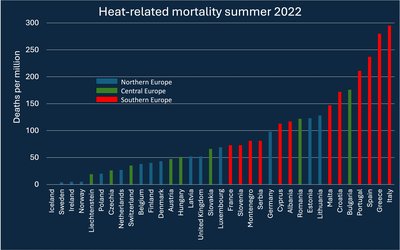Is global warming increasing heat-related mortality? Not in Sweden, so far!
September 11, 2018

Stockholm (photo: Bengt Nyman, www.flickr.com)
The impact of climate change on heat- and cold-related mortality varies within Europe and from one part of a country to another. Each region has its own optimum temperature from a health perspective, for which statistics show the lowest number of deaths. In Northern Europe, people are used to cold winters, while those in the South are used to hot summers. As a result, the optimum temperature, where mortality is lowest, is relatively low in Scandinavia and much higher in the Mediterranean.
The overall picture for Europe is that mortality will change under global warming: an increase of heat-related mortality will dominate over a decrease of cold-related mortality. This overall picture may not be correct, however. Adaptation is likely to offset some of future increases in temperature-related mortality. Besides, mortality is changing as a result of the changing standard of living and quality and accessibility of health care facilities.
For the Stockholm County in Sweden it was investigated whether cold- and heat-related mortality has already changed over the last century. This was done by studying daily mean temperatures and daily all-cause mortality for the period 1901-2013.
The results show that cold weather consistently had a larger impact on mortality than heat. Besides, the fraction of mortality that could be related to cold weather remained stable over time whereas the heat-related fraction decreased. These findings of a decline over time of the mortality fraction related to hot weather conditions are in line with a recent study of 305 locations in ten countries, where the authors reported a decline of this fraction over time in seven countries.
Overall, the effect of extreme temperatures on mortality in Stockholm has decreased, suggesting an effect of adaptation to increasing temperatures. In fact, the optimum temperature from a health perspective has increased in this region over the course of the twentieth century. More research is needed to enhance estimates of the burden related to cold and heat in the future.
Source: Åström et al., 2018. International Journal of Biometeorology 62: 1777-1780.








